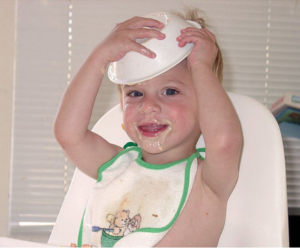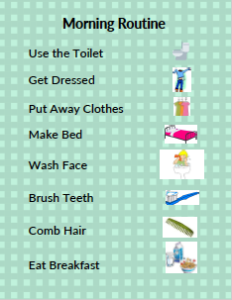Win the morning, win the day. We’ve all heard the expression. But, how do you win the morning when you have young children in the house? You don’t. But, you can make mornings more peaceful and set your children up for future independence by introducing a morning routine. Morning routines for children are important.
Creating a morning routine for your child will make everyone’s life easier. Not only will the morning routine provide structure and comforting familiarity, but it will also show that you have clear expectations that must be met before playtime or screen time begins.
The Importance of Routines for Children
Dani Kaufman, staff psychologist at Melbourne Child Psychology says,
‘Building routines with your children helps them to feel safe. They know what to expect when they go home, and it provides them with clear boundaries, expectations, and consistency.’
We want our children to feel safe at home. Children crave consistency and familiarity. Introducing a morning routine provides much-needed structure to the day. As Thomas W. Phelan, Ph.D. and author of 1-2-3 Magic: 3-Step Discipline for Calm, Effective, and Happy Parenting points out: “Morning often brings out the worst in everybody. Many people – both parents and kids – are naturally crabby at this point, and there is the additional strain of having to get someplace on time.”
The pressure of having to be somewhere on time makes it hard for parents to be patient in the morning. These conditions make stormy outbursts and tantrums more likely. Parents beware, especially if you haven’t had your first cup of coffee.
A morning routine eases some of the this pressure because everyone in the family knows what is expected of them.
There is a rise in anxiety in today’s world, especially among teens. With the increase in school shootings and terrorist attacks dominating the headlines, the world can seem to be a scary place. By providing a stable and predictable home environment we can do much to alleviate our children’s worries.
“In what some researchers have described as an ‘epidemic of anxiety’, the predictability and familiarity that comes with routine offers the perfect ‘safe space’ that kids need.”
Routines also help our children develop good habits. If they start with a winning morning routine in childhood, they will take this successful practice with them into adulthood.
Before
 Does this sound familiar? You struggle to dress you three-year-old while he watches TV hoping he doesn’t notice you are not putting on his favorite Spiderman T-shirt. Or, if you have a girl you hope she doesn’t cotton on to the fact that her sparkly unicorn shirt needs a wash.
Does this sound familiar? You struggle to dress you three-year-old while he watches TV hoping he doesn’t notice you are not putting on his favorite Spiderman T-shirt. Or, if you have a girl you hope she doesn’t cotton on to the fact that her sparkly unicorn shirt needs a wash.
After your clothes wrestling session, you must get your child to eat his/her breakfast. Your child has other plans. He/she doesn’t want to leave the TV. So, you shut it off.
The TV turn-off sets off a tantrum. A big one, too. You attempt to carry your crying, flailing child to the breakfast table. If your child doesn’t eat soon, you’ll be late for work.
After washing the orange bowl because your child insists on orange today, you finally convince him/her to eat.
Then it’s time for the brushing teeth battle. You don’t need all the ugly details here. You get the idea.
When I introduced a morning routine to my three-year-old son, things got so much better.
Now
Now my five-year-old and seven-year-old wake up and get through their morning routines in 10 minutes flat. They both make their beds and put away their pajamas. Sometimes I have to do quality control inspections on their teeth to make sure they are brushing well, but overall mornings are a breeze.
This didn’t happen overnight. I had to help my children with their routines one and off for a couple of years before they took ownership of them completely. Now, the motivation of 20 minutes of morning screen time gets the job done.
How to Set Up A Successful Morning Routine for Children
When I decided to implement a morning routine for my three-year-old, I looked online for ideas. After reading several sample routines, I finally settled on one that suited my expectations. This was our first morning routine:
- Go potty
- Get dressed
- Put away pajamas
- Make bed
- Brush teeth
- Wash face
- Comb Hair
- Eat breakfast
- Play/TV
- Bye! Bye!
Here is our current morning routine:

Yes, this is a lot of steps for a 3-year-old, but I did the routine with him each day. I made the decision to have my son complete all of his tasks before TV time or playtime. After a few days of heated protests, he finally realized I meant business.
A few weeks into our routine, I tweaked it to have my son brush his teeth before breakfast. I knew this wasn’t ideal from a dentist’s standpoint, but getting my son back up the stairs to brush his teeth after breakfast wasn’t working, so I made this compromise for the sake of my sanity.
Remember, once you have a basic framework for your morning routine you can always tweak it and improve it. I added sunscreen application to our morning routine when I kept forgetting to do it. Once it was on our list, we applied sunscreen every day.
When you create a morning routine for young children be sure to include pictures. Refer to the printed routine regularly. Model this for your child. You may even give him/her a dry erase marker to check off each task. I put our routine printout into a plastic sleeve so I could wipe away the dry erase check marks each day.
How to Implement Your Morning Routine
1. Set clear expectations.
2. Model the routine
3. Do it together
4. Your child does it independently
When you have a printed, illustrated routine posted prominently in the room it will serve as a reminder to you and your child that these expectations must be met before playtime begins.
By checking off each task you will teach your child responsibility. It also ensures that your child doesn’t forget any important tasks. He/she can’t say to you, “I forgot to make my bed” because the task is right there on the list.
Model the Routine
Initially, you will have to model the routine for your child, especially if you are starting young. Show your child what to do and help him/her complete each step.
Do it Together
Do the routine with your child. If you are starting young this may take a couple of years. Try not to send him/her down to watch TV while you keep sleeping. I know it’s painful some mornings, but imagine a future when your child wakes up and is entirely ready before you get out of bed. You’ll get there someday.
When my eldest started school, he would get up and get himself entirely ready some mornings because he was eager to start the day. Other days, he would whine and need me to help him with his routine. By his second year in school he was completing every aspect of his routine independently.
Your Child is Now Independent. You Win the Morning!
Congratulations! Your child is now independent. This is the final step. You’ve taught your child how to win the morning. This means you win the morning, too.
If you liked this post, you may find these helpful:
Establishing Routines for Children Will Make Your Life as a Parent Easier





